The best 12AX7 tubes for almost no money
For a newcomer it is not easy to navigate among NOS tubes that are available through Ebay or similar sites. The majority of the offerings are of contemporary Chinese or Russian origin and deceptively sold as rare vintage tubes, they are often marked with “military specifications” or they are gold pinned despite their NOS counterparts have never been produced like this. Should we buy a new tube to avoid the counterfeit?
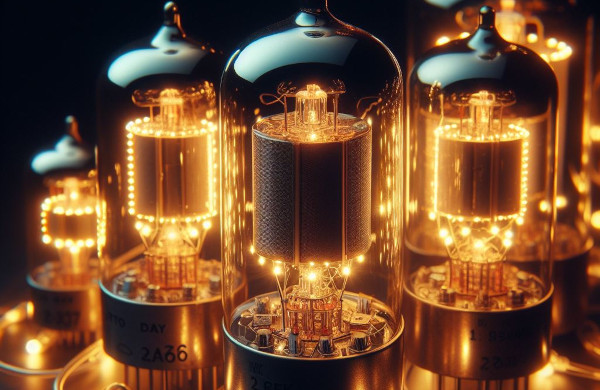
The 12AX7 is a high-mu twin triode (the mysterious ‚mu‘ means amplification factor, e.g. a tube with mu 10 amplifies the input voltage around 10 times) is the most often used tube in the preamp stages of audio equipment, be it a high-end application, a studio microphone preamplifier or a guitar preamp. It is, or perhaps I should write it was, one of the most available tubes from brands like Telefunken, Siemens, Mullard, GE, Tung-sol or RCA. Some 20 years ago the NOS (new old stock) supplies of these tubes were offered at ridiculously low prices, however, with the resurgence of the analogue niche of high-end audio the NOS tubes started to be highly sought after and today they have a “collector” status with corresponding purchasing prices attached to them.
The European versions of the 12AX7 were labelled as ECC83, ECC803 or 7025 tubes, the design principles are identical.
The longevity of tubes depends on many factors and can be as short as several hundred hours as well as 10,000 hours. However, the life of any tube will eventually end and the time of replacement comes. If you did not build sufficiently large stock of vintage tubes with (presumably) identical sonics the replacement of tubes will always mean change in sound. It is a kind of lottery with a lot of money involved. So it is actually easier to buy a new stock tube – not that it is not a lottery either, but at least it does not cost you fortune and the results are replicable. That’s why, in this review, I focused on the tubes that are commercially available and can be had at any quantity you ask for, and at reasonable prices. The review is not exhaustive, I especially regret that Sovtek and Electro Harmonix tubes did not make it in time for the review.
Methodology
Finding the optimum working conditions for each tube was a challenge – it was not clear what these optimum points were as each tube was pretty unique. That’s why each tube was granted 2 hours of run-in before it was critically listened to. Because the process included also a burning-in period of each tube for 2-3 days before it was used in the test, the whole review spread over several months. It was not possible to use the tubes in different applications as it would have made the review too complicated and there would have been no added value for all the variables could not have been eliminated anyway. It is quite important to realize that each audio component manufacturer uses certain types of valves during the gear development so the equipment is a kind of optimized for that brand. That’s why we only used one device, the SPL Stereo Vitalizer Mk2-T mastering processor that is a super-transparent piece of gear that contains two 12AX7s: one in the stereo signal processing path, another in the stereo width circuit. The sonic signature of each tube was thus easy to identify.
We did not use any measurement apparatus for noise, instead we run the signal from the Vitalizer unattenuated (full output from the CD player directly to the power amplifier) to listen to a valve’s inherent noise. This is a very extreme case which will hardly happen in real conditions where the audio signal – and noise too – will be attenuated below audible levels.
The tubes in the test
We’d like to thank Music Data, the distributor of German TAD tubes, that was patient with us and helped with some technical tips from the manufacturer. The other tubes were collected from different web-based shops. Here’s the list:
RT010: 7025 HIGH GRADE TAD PREMIUM SELECTED
RT011: 7025 S MULLARD-STYLE TAD PREMIUM SELECTED
RT011-HG: 7025 S MULLARD-STYLE TAD PREMIUM SELECTED HIGH GRADE
RT090: 5751 TAD HIGH GRADE, PAIRED
RT001: TAD ECC83-C PREMIUM SELECTED
RT033: TAD ECC803S PREMIUM SELECTED
TUNG-SOL 12AX7/ECC83 GOLD PIN
JJ ECC83S
JJ ECC83S GOLD PIN
JJ ECC83S MG
JJ ECC803S GOLD PIN
What we heard
The following music was used for evaluation by all reviewers in their respective systems: Violin Concertos of Korngold and Britten performed by amazing Vilde Frang (Frankfurt Radio Symphony, James Gaffigan, Warner Classic) that also represent a state-of-the-art of recording, The Very Thought of You by Nat King Cole (Analogue Productions DSD) and beautifully compiled German Stereoplay’s sampler Natural Bass Vol.1. The reviewers were responsible for matching the loudness levels during each listening round. Our listening notes read:
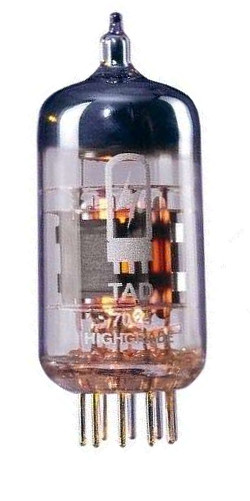
RT010: 7025 HIGH GRADE TAD PREMIUM SELECTED
- The RT010/7025 GH PS is ultra-quiet with very low noise levels, one of the best in the test.
- The sound is as if gold-dusted but it is not really warm. This combination makes a wonderful appearance for violins that are silky and smooth, yet detailed and real. During the pizzicato the tension of the string is a very palpable experience.
- The sound of the orchestra is slightly homogenized and its dynamics is a bit restrained – more openness and explosiveness would be appropriate.
- The body of the double-bass is more felt than heard. Transient is OK, followed by a soft thump which makes the sound slower and less defined despite the bass weight is quite good.
Resumé: The RT010/7025 GH PS is a kind of all-rounder and can be listened for hours. It has great soundstage, it is quiet and feeld analogue. The golden veil is attractive although it can be detected on everything you listen to so the tube actually colours the sound slightly. This is expected from tubes anyway, isn’t it? The bass and dynamics were softer but not unpleasant.
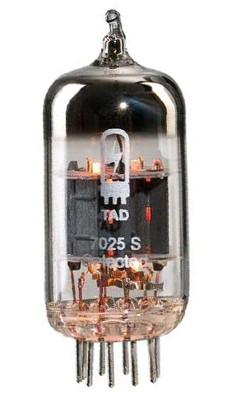
RT011: 7025 S MULLARD-STYLE TAD PREMIUM SELECTED
- The RT011 is a slightest bit noisier than the RT010.
- The sound is lively and neutral, yet tonally less accomplished than it should be.
- The soundstage is open with great front-to-back transparency.
- The RT011 provides more bass accuracy compared to the RT010. The drum kit is alive and dynamic.
Resumé: The RT011/7025 S Mullard-Style is quite a neutral tube that behaves like a solid-state device. It makes it a great companion for hi-fi applications or in combination with tubes that provide flavour and colour. On its own it may not be appealing to those who are looking for the “valve” sound.
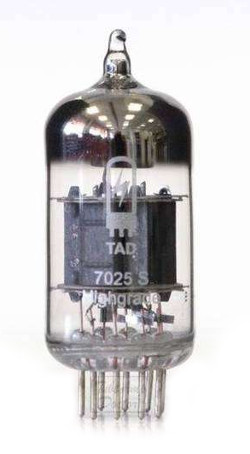
RT011-HG: 7025 S MULLARD-STYLE TAD PREMIUM SELECTED HIGH GRADE
- The RT011-HG is a very quiet tube, that is cleaner and more solid sounding than the previous tube.
- It has nice instrumental colours, it is fluid, smooth, detailed and “high-end”.
- Separation of individual instruments in the mix is excellent.
- The bass is full and textured. The male voice was tonally saturated, its timbre is rich and full of harmonics. The bass can be quite punchy if asked.
- Sibilants are a bit less accomplished, „s“ is smeared into „sf“. This is not an issue with the violin which is super-smooth and sweet. The saxophone is very convincing, quite close to what you can hear at a live performance.
- The soundstage is holographic, with massively involving depth. The sound embraces you and the solo voice just hangs right in front of us with mesmerizing palpability.
Resumé: The High Grade RT011 went an extra mile compared to the standard RT011. Sonically it is strong, three-dimensional and tonally rich. Everything (maybe except the sibilants) is detailed, balanced and articulated. I regret the little smear at around 9-10 kHz, which is something that will not make any issue with instrumental music.
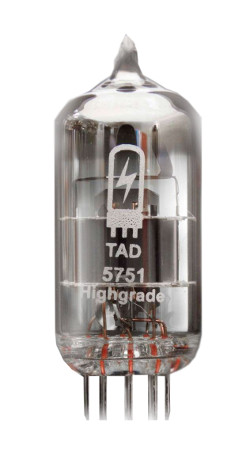
RT090: 5751 TAD HIGH GRADE, PAIRED
- High gain version, it is approximately +2dB louder than the RT011. Still it is a very quiet tube.
- The frequency response was uneven, a kind of top-down presentation with a subjective shallow dip in mids. That’s why this tube sounds very transparent and clean.
- The bass articulation is just good, the double-bass and the voice miss more punch and transient accuracy.
- The very deep lows are present in abundance, yet without the articulation the bass sounds slow.
- Though transparent and clean on top the tube does not exhibit tonal richness of its peers, rather it sound mechanical and uninvolving. The violin can sound wiry. The „s“ and „f“ sibilants are clean but stay a bit longer than needed, so they are presented as „sss“ and „fff“.
Resumé: What appears as great dynamic capabilities is a trade off for insufficient articulation and harmonic richness. The sound will be very much dependant on a selected application.
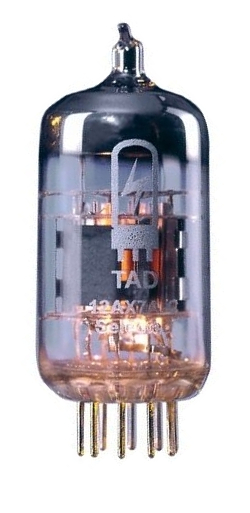
RT001: TAD ECC83-C PREMIUM SELECTED
- Another very quiet tube. Seems that TAD knows how to eliminate the noise.
- It is very good in microdynamics.
- The balance between detail and smoothness is just right. Some textures, like the bow’s friction on strings, are very real.
- It is not coloured yet it has the exact amount of warmth to sound beautiful. The tracks with plucked guitar strings are an audiophile event through this tube.
- The sustained tones are sound and well controlled, the transients are crisp and fast, the decays are long and ringing. The saxophone plays with realism, the rhythm section has great timing.
- The highs are very resolved and more accurate and open than those of the RT011-HG.
- The bass is full, round and warm. The symphony orchestra let you feel the size of the concert hall. The solo voice is great yet less mesmerizing than with the RT011-HG.
Resumé: The RT001/ECC83-C is less tantalizing and less dramatic than the RT-011 HG, however it betters it with more detail, a higher dose of neutrality and more accomplished textures. All this without any thinness or lack of character.
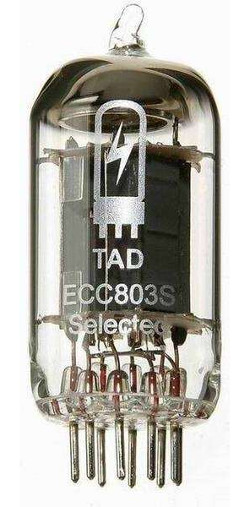
RT033: TAD ECC803S PREMIUM SELECTED
- The ultra-quiet tube, almost silent.
- It acknowledges virtues of the RT001 and removes its weak spots.
- The bass is present, weighty and punchy. Its transients are a tad softer, yet they are excellent and have a good grip.
- The sound is self-assured, clean and firm. The colours are slightly less vivid than with the RT001 a RT011-HG.
- Depending on the program material it can be a tiny bit less dynamic.
- The mids are fat and smooth. The music has a good flow and has a turntable vibe to it. Details are a bit suppressed, bowed strings are less textured.
- The RT033 is less opulent, less majestic and less charming than the RT-011 HG.
- The depth is a bit reduced, however its layers are very well resolved.
Resumé: A very good tube that does not outperform its competitors in any single parameter but it I so skilfully balanced that it does not have any critical drawbacks either.
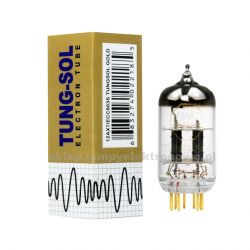
TUNG-SOL 12AX7/ECC83 GOLD PIN
- Quite a noisy tube, one of the noisiest in the test.
- Its soundstage has impressive depth but its lateral imaging is less intriguing: images stick to the centre and they never go beyond the left or right speaker.
- The top octaves are accented and the sound has good focus and detail which explains (together with the rather good price) why this tube has so many fans in hi-fi communities. Yet, after long listening, the tube is a bit sketchy and lacks charm.
- The bass is thinner and not really well controlled.
- Though expressive in highs, with the voice the sibilants are a bit too prominent and hiss of tape on the recordings remastered from analogue tapes is too obvious.
Resumé: The Tung-Sol Gold Pin is a kind of average tube. It is possible than perhaps some other production batches will behave differently, both units that were a part of our test were identical in sound, however.
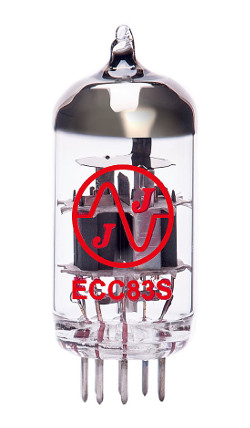
JJ ECC83S
- It is not noisy nor super-silent, an average.
- Fantastically balanced tube – no frequency excess identifiable, a benchmark for studio applications. It does not sound tubey, rather like a solid state device.
- Fabulous articulation. All the „s“ and „f“ are contoured and firm and very natural sounding on top of that.
- The most transparent tube of the test. Soft decays and ambient information is clearly audible, the tube lets you hear deep into the mix.
- Its highs are clean and free of any grain. The acoustic guitar is detailed, natural and accurate.
- The bass, though proportionally great, is slightly softer. Its transients are just good.
- Macro and micro dynamics are very good, the music has a lot of energy and juice. There is no congestion, the sound is open and fast.
- The soundstage width is from wall to wall, finely resolved. The front-to-back presentation is projected closer to the listener – the singer was at the level of speakers – yet the layers of the soundstage have analogue-like continuum.
- After circa 150 hours of playback one of the ECC83Ss got significantly noisier and had to be replaced. The other one showed no issues so it was probably just a faulty piece.
Resumé: A really transparent and firm sounding tube which is far away from the misconceptions about how coloured triodes sound. It is the only tube in the test I would not hesitate to use in any high-end application for its tonal honesty, provided that the listener compromises on the softer bass transients.
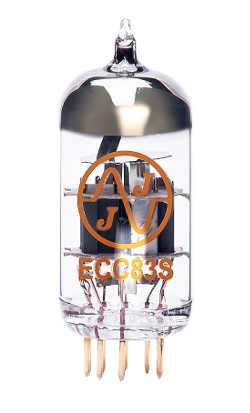
JJ ECC83S GOLD PIN
- The gold-pinned version of the JJ ECC83S is less alive and tuned down.
- The sibilants are rolled-off, still very competent.
- The bass is softer, it lacks punch. It is warm and round, though the double-bass is smeared. On the contrary synths are fantastic – rich and smooth.
- The acoustic guitar is too smooth with leading edges less defined. The cymbals have a silky feel, they are not metallic.
- The vocals are clean, especially the female voice has silkiness to it and though a bit reticent it is seductive in its smokiness.
Resumé: The gold-pinned JJ ECC83S GP is not so emotionally involving on some material. As if the sound could not unleash and dispense the haze. This tube will be good to tame some excessively bright equipment but it is not synonymous with transparency.
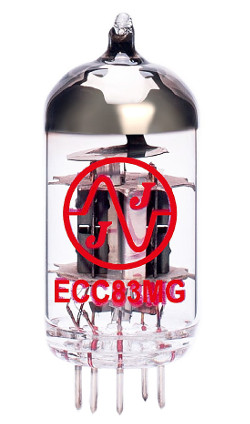
JJ ECC83S MG
- A quiet tube.
- The bass is not explosive, however it has the punch and energy.
- The cymbals are metallic, maybe too metallic, with slightly compressed dynamics.
- The tube modifies the soundstage: the sounds move to left and right speaker and the center image becomes weaker. In result voices are a kind of dual mono rather than presented with a strong central focus.
- The articulation in midrange is great, tonality is rich and colourful without coloration.
Resumé: The performance of this tube in stereo raises some serious questions especially about how it recreates the soundstage. In mono applications this will be no issue, however.
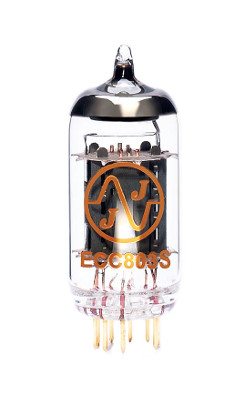
JJ ECC803S GOLD PIN
- A quiet, clean and harmonically rich tube.
- It exhibits the most firm bass of all the JJ tubes, and the bass also seems to dig a bit deeper than with the tube’s siblings.
- The dynamics are very good. The tube is very balanced across the frequency spectrum.
- The voices have accuracy and immediacy with a soft touch of warmth which reminds of a top vinyl record playback style.
- The highs are clean and crisp. They are also a bit forward so some violin pieces are perhaps too bright, but they never get harsh or shrilled.
- The soundstage is brilliant, the instruments are every naturally depicted within it, separation of images is great. A hologram.
Resumé: The best tube in the test. Despite tt lacks the mesmerizing quality of the TAD RT011-HG it delivers more open, dynamic and cleaner sound. An excellent choice for high fidelity applications.
How to remove microphony of tubes once and for all
During this review we usually played the music at fairly high volumes which highlighted one of the vacuum tube issues: the microphony. The SPL Vitalizer uses quite a clever solution to keep the tubes stay put – each tube is capped with a rubber ring that is a part of metal piece anchored by a bolt in the printed circuit board. The problem is that with every change of the tube one has to dismantle the Vitalizer as the bolt can only be accessed from the bottom of the device. Because during the review we kept the tubes in the Vitalizer without this clamping to enable easy swapping of the tubes, the microphony developed in full.
We tried to use trusted silicone rings (available from many sources) in different positions on the tubes and we used single pieces or doubled and tripled them. The result was similar to what you can expect with any soft and heavy dampening device – the transients became smeared and the sound lost articulation. This is because the rubber (or silicone) mass takes the mechanical energy from the tube or environment just to return it back a fraction of second later. The microphony is removed, the temporal precicion is impaired. Then we came across of Herbie´s Audio Lab.
Robert Herbelin, who runs the HAL, does a different thing. We got Herbie´s Audio Lab UltraSonic Rx Damping Instruments – this is how Robert calls a mildly spring-tempered titanium C-ring that holds three modified PTFE isolation pads. Each pad holds a specially formulated polymer O-ring against the tube glass. The whole system does not store any energy and the vibrations of the tube are dissipated through the titanium ring. And the UltraSonic Rxs really worked wonders.
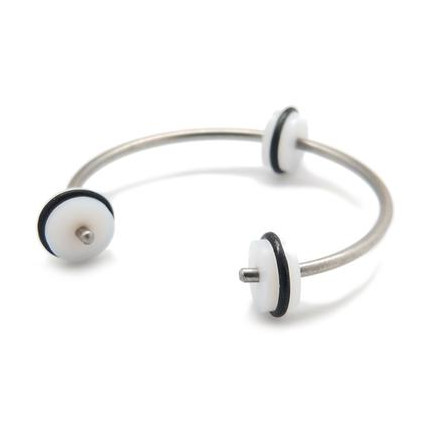
The UltraSonic Rx Damping Instruments not only did remove the microphony completely and did not add any smear to the sound, but they improved over the SPL’s proprietary solution too. For example, the rolling big drum was just a thundering massive wall of sound with the silicone rings in place. With the USRxDI the resolution stepped up several levels, each stroke of the mallet became delineated and the bass stopped masking other instruments of the symphony orchestra, thus making the music sound clearer and more transparent, yet digging deep, possibly deeper than before. We could also play 2-3dB louder without any congestion or constraints. Similarly the acoustic double-bass became highly contoured and more clearly locked within the soundstage, but rather than sounding too hi-fi it sounded wonderfully natural.
The tubes reacted quite sensitively to where the UltraSonic Rx Damping Instruments were positioned on the glass. We liked the placement ca 40% from the tube’s tip (on JJs) but each TAD responded differently. Some experimentation will be needed to find the sweet spot in your application.
A final word
There will be none. Our experience with the new no-NOS tubes is not 100% transferrable and we know it. Still, this test can give a bit of guidance of what to expect from the tubes of today and that it is not necessary to spend a fortune for legendary vacuum tubes on ebay when some fine sounding equivalents can be had from contemporary sources.
Where to buy TAD: Music Data, Velké Meziříčí, tel. +420 566 521 370
Where to buy JJ: Elektronky.com, tel. +421 907 025 707



